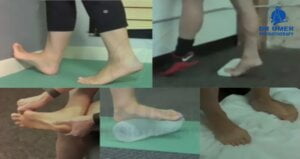The most affective exercises for Plantar Fasciitis. It helps to improve the blood circulation in the plantar fascia.
Plantar Fascia Stretch
Sit straight on bed or chair by crossing the affected leg over the unaffected leg. Use your hand to keep your fingers across the base of the toes on the foot. Pull the toes up toward the shin until you feel a stretch in the arch of the foot. You can also palpate the tension in the plantar fascia to make sure that it’s being done correctly. Hold this stretch for 10 seconds. Repeat 10 times and do this exercise 3 times a day.
Heel Raise
Stand straight. Place a towel under the one toe of your foot. Raise your second leg. Hold the wall or something for support. Rising up the one heel to make sure maximum dorsi flexion of the toe at the top of the heel raised. Rising up to a count of 3 seconds, hold at the top for 2 seconds then slowly coming down to a count of 3 seconds. Do 3 sets of 10 repetitions. If you feel easy after one week then you can add the weight in your back with the face of school bag with some books on it or water bottle. And if you feel hard with one leg raise so then, you can also do with two legs.
Wall Calf Stretch
Stand in-front of wall and hold the wall for support. Put the toe of your foot on the wall with keeping the heel on the floor. Your toes are extended as well as your knees. Then comes forward and rasie the heel of your second foot. Now relax and do 10 repetitions.
Toe Curl
Sit on the chair and put the towel on the slippery floor. Curl your toes and pull the towel back toward your heel. Make sure that you are using all of your toes. Do 10 repetitions. Now, forcing the towel back out. Do 10 repetitions. So, you have to do both forward and back. Do 3 sets of 10 repetitions.
Bottle Roll
Take a water bottle and freeze it. Sit on the chair and take the bottle under the foot. Roll the bottle to your foot for getting the good massage. Do this massage at-least 10 to 15 minutes.

Role of Physiotherapy in Plantar Fasciitis
In plantar fasciitis, the patients comes with complain of pain in the bottom of foot. The most common symptom is, patient have severe pain in morning or while standing and walking. As patient continues walking, the pain severity is low down and pain worse again at night. Physical therapist helps you to diagnose the reason of pain. Physiotherapist suggest you the exercises for Plantar fasciitis and the precautions that you have to follow. These exercises are really easy that you can do in the morning before leaving the bed. It prevents you pain and irritation on the morning in first standing and walking position. It also helps you to increasing the blood flow in the affected area to warm the tissue.
Physiotherapist also uses different types of techniques for reducing pain like electrical therapy and ultrasonic therapy. The combination of exercises and electrical therapy helps you to increase the mobility and reducing pain.
Who are facing Plantar Fasciitis?
Plantar fasciitis is more common in two types of population.
The first is younger which are more active like runners who actually have higher training volumes or who are doing standing in long period at their work. The second one is older patients with a higher mass.
It is important to point out that other lifestyle factors like lack of sleep, stress and anxiety also plays a role in plantar fasciitis. This is also important to analyze the relationship between load and capacity. The goal of rehab is to balance your capacity and your load. The capacity is should be greater than or equal to the various loads that you are experiencing on a daily basis.


